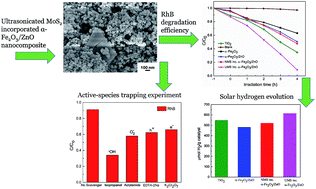MoS2 nanosheet incorporated α-Fe2O3/ZnO nanocomposite with enhanced photocatalytic dye degradation and hydrogen production ability†
Abstract
We have synthesized MoS2 incorporated α-Fe2O3/ZnO nanocomposites by adapting a facile hydrothermal synthesis process. The effect of incorporating ultrasonically exfoliated few-layer MoS2 nanosheets on the solar-light driven photocatalytic performance of α-Fe2O3/ZnO photocatalyst nanocomposites has been demonstrated. Structural, morphological and optical characteristics of the as-synthesized nanomaterials are comprehensively investigated and analyzed by performing Rietveld refinement of powder X-ray diffraction patterns, field emission scanning electron microscopy and UV-visible spectroscopy, respectively. The photoluminescence spectra of the as-prepared nanocomposites elucidate that the recombination of photogenerated electron–hole pairs is highly suppressed due to incorporation of MoS2 nanosheets. Notably, the ultrasonicated MoS2 incorporated α-Fe2O3/ZnO nanocomposite manifests 91% and 83% efficiency in degradation of rhodamine B dye and antibiotic ciprofloxacin respectively under solar illumination. Active species trapping experiments reveal that the hydroxyl (˙OH) radicals play a significant role in RhB degradation. Likewise the dye degradation efficiency, the amount of hydrogen produced by this nanocomposite via photocatalytic water splitting is also considerably higher as compared to both non-ultrasonicated MoS2 incorporated α-Fe2O3/ZnO and α-Fe2O3/ZnO nanocomposites as well as Degussa P25 titania nanoparticles. This indicates the promising potential of the incorporation of ultrasonicated MoS2 with α-Fe2O3/ZnO nanocomposites for the generation of carbon-free hydrogen by water splitting. The substantial increase in the photocatalytic efficiency of α-Fe2O3/ZnO after incorporation of ultrasonicated MoS2 can be attributed to its favorable band structure, large surface to volume ratio, effective segregation and migration of photogenerated electron–hole pairs at the interface of heterojunctions and the plethora of exposed active edge sites provided by the few-layer MoS2 nanosheets.



 Please wait while we load your content...
Please wait while we load your content...